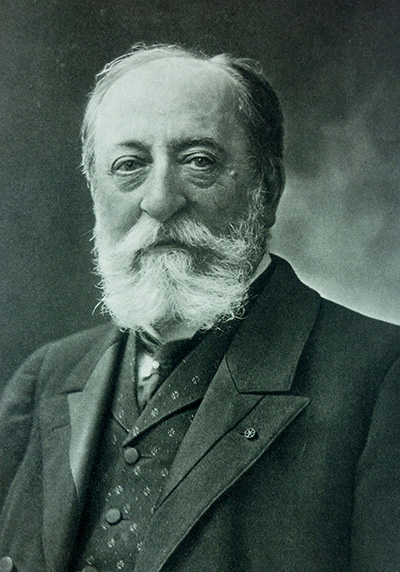Camille Saint-Saëns

Born: October 9, 1835, Paris
Died: December 16, 1921, Algiers
Concerto No. 3 in B Minor for Violin and Orchestra, Op. 61
- Composed: 1880
- Premiere: January 2, 1881 in Paris, with Pablo de Sarasate as soloist
- CSO Notable Performances:
- First: March 1896, Frank Van der Stucken conducting; Emile Sauret; violin
- Most Recent: February 1998, Rafael Frühbeck de Burgos conducting; Joshua Bell, violin
- Instrumentation: olo violin, 2 flutes (incl. piccolo), 2 oboes, 2 clarinets, 2 bassoons, 2 horns, 2 trumpets, 3 trombones, timpani, strings
- Duration: approx. 29 minutes
Camille Saint-Saëns was the Renaissance man among the great French composers. His interests extended well beyond music to include the sciences (especially astronomy), theater, drawing and caricature, archeology, poetry, mathematics and literature. The noted American critic Philip Hale left a memorable sketch of him: “He was of less than average height, thin, nervous, with a great and exposed forehead, hair habitually short, beard frosted. His eyes were almost level with his face. His eagle-beak would have excited the admiration of British general Sir Charles Napier, who once exclaimed: ‘Give me a man with plenty of nose.’ Irritable, whimsical, ironical, paradoxical, indulging in sudden changes of opinion, he was faithful to his friends, appreciative of certain rivals, kindly disposed toward young composers, zealous in practical assistance as well as verbal encouragement. [He was] a man that knew the world and sparkled in conversation; fond of society; at ease and on equal terms with leaders in art, literature, fashion.” In his compositions, Saint-Saëns always sought simplicity and clarity of form realized with appealing sonority, harmony and melody but devoid of excess pathos; he wrote in 1913, “He who does not take thorough pleasure in a simple chord progression, well-constructed, beautiful in its arrangement, does not love music; he who does not prefer a lovely folk tune to a series of dissonant and pretentious chords does not love music.” Saint-Saëns’ is an art of beauty, of precision, of formal perfection—a flawless realization by a master craftsman.
The Third Violin Concerto, one of the happiest inspirations to flow from Saint-Saëns’ pen, is a fine example of his elegant style, and the most popular of his three works for violin in the form. It opens with a presentation of the main theme by the soloist above a tremulous rumble in the strings and timpani. This theme gathers intensity amid the refined figurations of the violin and leads to a lyrical contrasting melody. A compact development of the main theme occupies the center of the movement. Saint-Saëns, always careful with the balance of his forms, begins the recapitulation with the lyrical second theme since the main theme exclusively had been used in the just-heard development. This also allows the main theme to be held in reserve to provide the movement with a vigorous, B minor conclusion.
The second movement is a sweet barcarolle of simple but suave melodic character. The finale begins with a Romani-inspired flourish from the soloist as introduction. The pace then quickens for the fleet main theme. Two contrasting melodies, one heroic, the other prayerful, are presented for variety. A short connecting passage ushers in the recapitulation of all the themes: Romani introduction, fleet main theme, heroic contrasting theme. The prayerful theme is treated boldly on its second appearance as a majestic hymn for brass chorale. The tempo freshens for the final dash to the end—a brief, exhilarating coda based on the heroic contrasting theme.
—Dr. Richard E. Rodda